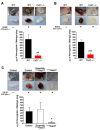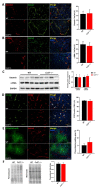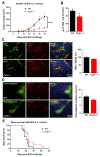Targeting Endothelial Connexin37 Reduces Angiogenesis and Decreases Tumor Growth
- PMID: 35328350
- PMCID: PMC8948817
- DOI: 10.3390/ijms23062930
Targeting Endothelial Connexin37 Reduces Angiogenesis and Decreases Tumor Growth
Abstract
Connexin37 (Cx37) and Cx40 form intercellular channels between endothelial cells (EC), which contribute to the regulation of the functions of vessels. We previously documented the participation of both Cx in developmental angiogenesis and have further shown that loss of Cx40 decreases the growth of different tumors. Here, we report that loss of Cx37 reduces (1) the in vitro proliferation of primary human EC; (2) the vascularization of subcutaneously implanted matrigel plugs in Cx37-/- mice or in WT using matrigel plugs supplemented with a peptide targeting Cx37 channels; (3) tumor angiogenesis; and (4) the growth of TC-1 and B16 tumors, resulting in a longer mice survival. We further document that Cx37 and Cx40 function in a collaborative manner to promote tumor growth, inasmuch as the injection of a peptide targeting Cx40 into Cx37-/- mice decreased the growth of TC-1 tumors to a larger extent than after loss of Cx37. This loss did not alter vessel perfusion, mural cells coverage and tumor hypoxia compared to tumors grown in WT mice. The data show that Cx37 is relevant for the control of EC proliferation and growth in different tumor models, suggesting that it may be a target, alone or in combination with Cx40, in the development of anti-tumoral treatments.
Keywords: angiogenesis; cell-cell communication; connexins; transgenic mice; tumors.
Conflict of interest statement
The authors declare no conflict of interest. The funders had no role in the design of the study; in the collection, analyses or interpretation of data; in the writing of the manuscript; or in the decision to publish the results.
Figures







Similar articles
-
Decreased intercellular dye-transfer and downregulation of non-ablated connexins in aortic endothelium deficient in connexin37 or connexin40.J Cell Sci. 2003 Jun 1;116(Pt 11):2223-36. doi: 10.1242/jcs.00429. Epub 2003 Apr 15. J Cell Sci. 2003. PMID: 12697838
-
Targeting connexin37 alters angiogenesis and arteriovenous differentiation in the developing mouse retina.FASEB J. 2020 Jun;34(6):8234-8249. doi: 10.1096/fj.202000257R. Epub 2020 Apr 22. FASEB J. 2020. PMID: 32323401
-
Role of connexin37 and connexin40 in vascular development.Cell Commun Adhes. 2003 Jul-Dec;10(4-6):379-85. doi: 10.1080/cac.10.4-6.379.385. Cell Commun Adhes. 2003. PMID: 14681045
-
Gap junctions and the connexin protein family.Cardiovasc Res. 2004 May 1;62(2):228-32. doi: 10.1016/j.cardiores.2003.11.013. Cardiovasc Res. 2004. PMID: 15094343 Review.
-
Role of connexins in microvascular dysfunction during inflammation.Can J Physiol Pharmacol. 2011 Jan;89(1):1-12. doi: 10.1139/y10-099. Can J Physiol Pharmacol. 2011. PMID: 21186372 Review.
Cited by
-
The roles of connexins and gap junctions in the progression of cancer.Cell Commun Signal. 2023 Jan 13;21(1):8. doi: 10.1186/s12964-022-01009-9. Cell Commun Signal. 2023. PMID: 36639804 Free PMC article. Review.
-
Construction and validation of a prognostic model of angiogenesis-related genes in multiple myeloma.BMC Cancer. 2024 Oct 11;24(1):1269. doi: 10.1186/s12885-024-13024-9. BMC Cancer. 2024. PMID: 39394121 Free PMC article.
-
Connexins and angiogenesis: Functional aspects, pathogenesis, and emerging therapies (Review).Int J Mol Med. 2022 Aug;50(2):110. doi: 10.3892/ijmm.2022.5166. Epub 2022 Jun 28. Int J Mol Med. 2022. PMID: 35762312 Free PMC article. Review.
References
MeSH terms
Substances
Grants and funding
LinkOut - more resources
Full Text Sources
Medical
Molecular Biology Databases

